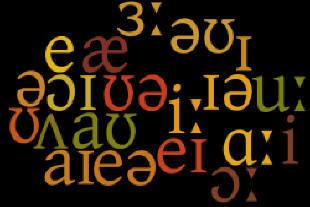Vowels

If anything in the first part of this guide is unfamiliar to you, you should probably take a little time to refresh your memory concerning the essential concepts in pronunciation. You can open that guide in a new tab by clicking here.
Two questions:
- Can you define 'vowel'?
- What are the vowel sounds of English?
Click here when you have an answer.
- When you produce a sound by completely or partially blocking the flow of air through the vocal tract, you produce a consonant. When you don't restrict the airflow at all, you produce a vowel. All vowels are, therefore, voiced in the sense that the sounds made by your vocal folds are affected by the shape of the channel through which the air flows.
- Here's the usual list with examples. There are 21 vowel
sounds but only 6
letters in the alphabet to represent them (A, E, I, O, U and Y (in
some cases)). Authorities differ in how vowels are
counted.
The sounds in the grey cells are the pure vowels or monophthongs and those in the pink cells are diphthongs which are combinations of two pure vowels.
| /iː/ | sleep sheep free |
/æ/ | sat hat flab |
/ɪə/ | here beer mere |
| /ɪ/ | kid slid blip |
/ʌ/ | blood cup shut |
*/ʊə/ | during furious pure |
| /ʊ/ | put foot suit |
/ɑː/ | part large heart |
/ɔɪ/ | boy deploy toy |
| /uː/ | goose loose Bruce |
/ɒ/ | hot cot shod |
/eə/ | lair share prayer |
| /e/ | Fred dead said |
†/i/ | happy navvy sally |
/eɪ/ | lace day betray |
| /ə/ | about father across |
/aɪ/ | price wine shine |
||
| /ɜː/ | verse hearse curse |
/əʊ/ | boat coat note |
||
| /ɔː/ | fought caught brought |
/aʊ/ | south house louse |
||
* This diphthong in the example words is not pronounced by all
speakers. For example, sure may be pronounced with the
diphthong as /ʃʊə/ or with a monophthong as /ʃɔː/
† /i/ may be transcribed as /iː/ in some analyses.
Because we only have 6 letters for 21 sounds, we need to use the
symbols above to represent things accurately.
Estimates of the number of vowels vary because, unlike consonants, it is
sometimes hard to determine when one vowel ends and the next begins.
It is also the case that the distinction between a vowel and a consonant
is not quite as straightforward as some references (especially those for
learners) would have you believe. For example, /h/ and /w/ are
usually defined as consonants but in English the sounds are made with an
unrestricted airflow and are therefore more vowel-like than obvious
consonants such as /p/ or /v/.
Languages differ, too, in how vowels are categorised so, for example,
/r/ is, in English, generally recognised as a consonant but in Mandarin
it is a vowel.
Following some analyses, it makes more sense to talk about the distribution of sounds rather than their manner of production so, for example, sounds which, in English, can come between and initial /p/ and a final /t/ are all vowels as are those which can follow an initially placed /m/. This is specific to English, because other languages allow different distributions. For example, in German, /f/ may follow /p/ and in Greek, /n/ may follow /ɡ/ but in English neither is permitted. (We are talking about sounds not letters here, naturally.) The issue is part of the phenomenon of phonotactics to which there is a guide on this site (new tab).
Vowel sounds are one of the areas in which regional or various standard differences in pronunciation show most clearly. For this reason, multiple examples are given above. What follows in this area is based, slightly loosely, on RP, the British variety known as Received Pronunciation or BBC English. For example, the word house is given as an example of the /aʊ/ diphthong but in many varieties of English the vowel would closer to /æ/ or /uː/.
 |
Classifying vowels |
Monophthong vs. Diphthong vs. Triphthong
Monophthongs are produced and perceived as having a single quality.
These are sometimes called the pure vowels. An example is the /ʊ/
sound in foot.
Diphthongs are perceived as starting with one vowel and gliding towards
another. An example is the first vowel /ʊə/ in during which
is formed by starting with the /ʊ/sound as in full and then moving to the /ə/
sound as in about.
The word about also contains a diphthong. It is
transcribed as /ə.ˈbaʊt/ and the second vowel is a combination of a
short /a/ and /ʊ/.
 |
Monophthongs |
There are four things to know about any vowel:
- Tongue height: is the main part of the tongue high
in the mouth or low? Three positions are recognised:
- High: at the top of the mouth in vowels such as /iː/ and /uː/ in beat and boot respectively.
- Mid: in an intermediate position in vowels such as /e/ and /ɔː/ in bet and bought respectively.
- Low: lying flat on the bottom of the mouth in vowels such as /æ/ and /ɒ/ in pat and pot respectively.
- Tongue position: where is the main part of the
tongue? Three more positions are recognised:
- Front: with the tongue towards the front of the mouth as in the vowels /e/ and /iː/ in bed and bead.
- Central: with the tongue central in the mouth in vowels such as /ə/ and /ɜː/ in about and verse.
- Back: with the tongue at the back of the mouth as in the vowels /ɒ/ and /ɑː/ as in hot and heart.
Traditionally, these two characteristics are plotted on a grid like this (the front of the mouth is to the left):

The diagram above does not concern what are known as cardinal vowels.
Cardinal vowels are a standard set of sounds against which the vowels of
any human language can be measured and described.
The diagram here concerns the major vowels in English but individual speakers will differ in their production.
Individual authorities will also differ slightly in exactly where all
the vowels are positioned on the grid. In the diagram, for the
sake of clarity, we have not allowed the sounds to overlap but /i/ and
/iː/ are formed in the same way and are differentiated only by length
and the same can be said for /ə/ and /ɜː/.
If you try saying beat, bit, bet, boot, verse, cup, cap, the, noose,
foot, hot, fought, bark you will feel the tongue position change
from left to right, top to bottom of the grid. It'll also move up and down and forward and back depending on the vowel.
Try it.
The vowels in those words are:
| Word | Vowel | Word | Vowel | Word | Vowel |
| beat | iː | bit | ɪ | bet | e |
| boot | uː | verse | ɜː | cup | ʌ |
| cap | æ | the | ə | foot | ʊ |
| hot | ɒ | fought | ɔː | bark | ɑː |
We can also add a 13th vowel, /i/, which is the sound of the letter 'y' at the end of party. It is a shortened version of /iː/. Some will not recognise this sound as a distinct vowel, conflating it with /iː/ and it is true that speakers differ in how long they make the sound and it is also true that both sounds are high, front vowels formed with the tongue in an identical position.
- Length: some vowels
are represented with a colon following them. This is the
length mark. Compare the sounds of /ə/ and /ɜː/, for example,
in Herbert. The first is longer and the transcription is
/ˈhɜː.bət/
Length is, of course, relative and vowels can be made longer or shorter by any speaker of English.
There is a significant tendency in English to make vowels slightly longer when they occur before a voiced (lenis) consonant so before /b/, /dʒ/, /v/, /z/, /ɡ/, /d/, /ð/ and/ʒ/ the vowels will be slightly longer than they are before /p/, /tʃ/, /f/, /s/, /k/, /t/, /θ/ and /ʃ/. For example, the vowels in the words on the right are longer than those on the left:
In a broad, phonemic rather than phonetic transcription, such as we are using here, no marking of the vowel is made to represent this change in length.Short Long cap cab catch cadge safe save mace maze lock log cart card - Short vowels
Conventionally, there are, in English the following eight short vowels (although the last of these is often conflated with the first long vowel):- /ɪ/ as in kid or blip. To make this sound, the lips are only slightly spread. Spreading them further produces the longer sound /iː/ and that is a common error for speakers whose languages do not have the short vowel.
- /e/ as in dead or said.
- /æ/ as in hat or ban.
- /ʌ/ as in cup or luck.
- /ɒ/ as in got or pot.
- /ʊ/ as in foot or put.
- /ə/ as in the first syllable of about and the last of father.
- /i/ as at the end of happy or savvy
- Long vowels
The following are the long vowels which are all marked to show length with the length mark: 'ː'. The length mark is actually only for convenience in terms of remembering that the vowel is long. The symbols are, with one exception, different from the short vowels even without the length mark. The following five are the long vowels:- /iː/ as in sheep or neat. It is the lengthened version of /i/ and /ɪ/.
- /ɜː/ as in verse or nurse. It is the lengthened version of /ə/ and is sometimes transcribed as /əː/.
- /ɑː/ as in car or bar.
- /ɔː/ as in taught or bought. It is the lengthened form of /ɒ/ and that vowel is sometimes transcribed as /ɔ/.
- /uː/ as in moose or shoe. It is the lengthened form of /ʊ/ and that vowel is sometimes transcribed as /u/.
- Short vowels
- Lip rounding: some vowels are formed in
English with rounded lips. These are /ʊ/, /uː/, /ɔː/ and /əʊ/.
Try looking in a mirror and saying, foot, loose, caught, load.
You can see the lips rounding. The amount of rounding varies
and this affects the sound. Other vowels, such as /e/ and /iː/
are not rounded but the latter requires lateral stretching of the
mouth – say cheese.
There are three alternatives, although there is a cline from fully rounded to fully stretched via the neutral position. If you look at yourself in a mirror while pronouncing the vowels in the table above, you will be able to see how your lips are positioned for each sound:- rounding as in /ʊ/ or /ɔː/ etc.
- stretching as in /iː/ or /e/ etc.
- neutral as in /ə/ or /ɜː/ etc.
Now it's possible for you to classify thirteen vowels in English by type,
like this. It also provides a handy reference for any minimal pair
work you may like to do in the classroom to get learners to hear and
produce the differences.
A productive exercise is to take vowels which differ in only one
characteristic and use them for practice. That way,
learners can focus only on height, position, length or roundedness and
are not distracted by having to make multiple changes to distinguish the
sounds when they speak.
| Vowel | height | position | length | roundedness | minimal pairs |
| /iː/ | high | front | long | stretched | bit / beat happy / carefree |
| /ɪ/ | high | front | short | stretched | |
| /i/ | high | front | short | stretched | |
| /ʊ/ | high | back | short | rounded | full / fool |
| /uː/ | high | back | long | rounded | |
| /e/ | mid | front | short | neutral | errand / around |
| /ə/ | mid | central | short | neutral | |
| /ɜː/ | mid | central | long | neutral | hurt / hot |
| /ɒ/ | mid | back | short | rounded | |
| /ʌ/ | low | central | short | neutral | cup / cap |
| /æ/ | low | front | short | neutral | |
| /ɔː/ | low | back | long | rounded | caught / cart |
| /ɑː/ | low | back | long | neutral |
The /i/ sound appears in this table but does not form part of a minimal pair except when it is contrasted with /ɪ/ or /iː/.
For more ideas for teaching, see the guide to teaching troublesome sounds (new tab).
 |
Diphthongs |
As we said, these are sounds made by starting with one pure vowel and gliding towards another. There are eight of these in English. The easiest way to remember them is to see where they are going. There are three sorts:
- Ending in /ə/. Because the /ə/ is the archetypal central
vowel in English, these are called the centring diphthongs and there
are three of them:
- /ɪə/ as in here or beer. The sound starts with the short vowel /ɪ/ and glides at the end to the /ə/ sound.
- /eə/ as in lair or pair. Start with /e/ and move to the /ə/.
- /ʊə/ as the first vowel in during or (in some
people's production) pour. Start with /ʊ/
and move to /ə/.
This sound is now becoming quite rare, being confined mostly to dialect or very careful RP speech. These days, the vowel on words such as sure and poor is usually transcribable as /ɔː/. It is more often present in longer words such as individual (/ˌɪn.dɪ.ˈvɪ.dʒʊəl/).
- Ending in /ɪ/. These are described as closing diphthongs
because the tongue moves towards the roof of the mouth, closing off
the airflow. There are also three of these:
- /eɪ/ as in day or hay. Start with /e/ and move to /ɪ/.
- /aɪ/ as in price or nice. Start with a shortened /aː/ and move to /ɪ/.
- /ɔɪ/ as in boy or coy. Start with /ɔ/ and move to /ɪ/. In this diphthong, the first sound is a little more open and shorter than the sound /ɔː/ in bought or caught.
- Ending in /ʊ/. These are also closing diphthongs because
the tongue moves towards the roof of the mouth. There are only
two (in English):
- /əʊ/ as in boat or vote. Start with /ə/ and move to /ʊ/.
- /aʊ/ as in south or louse. Start with a shortened /aː/ and move to /ʊ/.
The most important thing to know about diphthongs (apart from how to produce, recognise and transcribe them) is that the initial sound is the most recognisable with the second vowel usually being much shorter and less distinct.
 |
Triphthongs |
These sounds do not appear in all analyses for two reasons:
- They are by no means easy to identify
- They only exist in certain varieties of English and can, for learners, generally be safely ignored
They do, nevertheless exist (allegedly) and there are, what's more, five of them.
Whether you produce all five when you speak is a matter of the accent
you use and your background as well as how carefully and slowly you are
trying to enunciate.
These sounds are diphthongs which then take a further glide towards the
schwa /ə/.
The diphthong with which these sounds begin is the most noticeable sound
and the final glide to the schwa is, for many people, unrecognisable and
also not produced in a lot of people's speech.
Here's the list with the example words:
- /eɪə/ as in player or mayor. Start with the diphthong /eɪ/ (as in say) and glide from the end of that to the /ə/.
- /aɪə/ as in liar or shire. Start with the diphthong /aɪ/ (as in nice) and glide to the /ə/.
- /ɔɪə/ as in soil or loyal. Start with the diphthong /ɔɪ/ (as in toy) and glide to the /ə/.
- /əʊə/ as in lower or knower. This one has a schwa at both ends. Start with the diphthong /əʊ/ (as in coat) and glide to the /ə/.
- /aʊə/ as in tower or our. Start with the diphthong /aʊ/ (as in mouth) and glide to the /ə/.
Now, some people will pronounce these sounds as two syllables so
the transcriptions are separated with a '.' to show the syllables.
Some will pronounce the sounds without any interruption as a single
syllable so the '.' will not appear. So, for example:
slayer: /ˈsleɪə/ or /ˈsleɪ.ə/
tyre: /ˈtaɪə/ or /ˈtaɪ.ə/
toil: /ˈtɔɪəl/ or /ˈtɔɪ.əl/ (but many pronounce that
as /tɔɪl/, a single-syllable word with a diphthong vowel sound)
mower: /ˈməʊə/ or /ˈməʊ.ə/
shower: /ˈʃaʊə/ or /ˈʃaʊ.ə/
Some people do not pronounce all the triphthongs in all the words in
which they could potentially appear, preferring to stick with a
diphthong sound only.
The argument about whether there is, in fact, such a thing as a
triphthong in English can be summarised like this:
Wells:
I would argue that part of the definition of a
true triphthong must be that it constitutes a single V unit, making
with any associated consonants just a single syllable.
Given that, do we have triphthongs in English? I claim that
generally, at the phonetic level, we don’t. I treat the items we are
discussing as basically sequences of a strong vowel plus a weak
vowel.
Wells, 2009
Roach:
The most complex English sounds of the vowel
type are the triphthongs. They can be rather difficult to pronounce,
and very difficult to recognise. A triphthong is a glide from one
vowel to another and then to a third, all produced rapidly and
without interruption.
Roach, 2009:29 (emphasis added)
Crystal:
The distinction between triphthongs and the
more common diphthongs is sometimes phonetically unclear.
Crystal, 2008:497
Summaries
Here are some summary charts which may be helpful.
All vowels:

Monophthongs only:

Diphthongs only:

Triphthongs only:

 |
Markedness and phonemic substitution |
Markedness in this sense refers to how widely vowels are represented in the world's languages. That, it is sometimes averred, is a measure of how hard they are to acquire. The common sounds will give few problems but vowels which are not represented in the learners' first language(s) will, understandably, cause significant problems.
There is evidence to suggest that the high vowels,
especially, /ʊ/, /uː/, /iː/ and /ɒ/ are common to a wide range of
languages and are, therefore, considered unmarked. They should
cause few learners any significant trouble.
On the other hand, some,
often lower, vowels, particularly /ɑː/, /ɔː/, /ɜː/, /ʌ/, /ɪ/
and /æ/ are marked in that they do not occur with anything
like the same frequency in many languages so they require more attention.
Some languages have no equivalents of these sounds and learners will
usually produce the nearest fit with their first-language sounds
resulting in, notably, mistaking /iː/ for /ɪ/ (hit vs. heat) and /ɒ/ for /ɑː/
(hot vs. heart).
This is a form of phonemic substitution. Some attention to where the tongue is positioned and vowel length is
called for in terms of teaching these.
There is a guide on this site to teaching troublesome sounds which considers many of the more marked, i.e., less common, vowel sounds.
 |
Semi-vowels |
Semi-vowels are sounds which are produced like vowels but actually
don't function like them. An example is the /j/ sound at the beginning
of the word yet (/jet/). The y letter represents
a consonant in this case but at the end of the word fly, it is
a vowel and transcribed as /flaɪ̯/.
The letter w also has
this characteristic: at the beginning of was it is close to
being a consonant (called a glide, in the trade) but in the centre of
cower it is part of a triphthong vowel sound so the transcription of was
cowering is /wəz ˈkaʊər.ɪŋ/.
Three semi-vowels, /w/, /j/ and /r/ are the subject of intrusion, covered in the consideration of connected speech to which guide you are referred for more.
One, /j/, is often inserted by British speakers in words such as
tune, fortune, produce, century, nature, mixture, picture, creature,
opportunity, situation, actually in which the /t/ or /d/ sound is
followed by a /j/ not shown in the spelling.
Therefore, the transcription is actually:
tune /tjuːn/
actually /ˈæk.tjuə.li/
situation /ˌsɪ.tjʊ.ˈeɪʃ.n̩/
etc. although ˈæk.tʃuə.li/ and /ˌsɪ.tʃʊ.ˈeɪʃ.n̩/ are also heard.
 |
Allophones and regional variations |
- individuals vary
- No two speakers pronounce all vowels in exactly the same
way. Individual speakers will also pronounce some
vowels differently depending on how they feel, how carefully
they wish to speak and how quickly. So, for example,
we might pronounce happy in:
I'm happy to say
as /ˈhæp.i/
and on another occasion, we might pronounce the word in
Be happy!
as /ˈhæp.iː/
with a longer final vowel.
Most vowels in English can be lengthened or shortened in rapid or slow speech without affecting the meaning that is heard. - accents vary
- Where people come from may also have a significant effect.
In some parts of Britain, for example, the words beauty
and booty will be pronounced the same as /ˈbuː.ti/ but
in Standard English there will be a difference with beauty
pronounced with an intrusive /j/ sound as /ˈbjuː.ti/ and the
word booty pronounced as /ˈbuː.ti/.
In British English, the word stupid is usually pronounced as /ˈstjuː.pɪd/ but in Standard American, that is often /ˈstuː.pɪd/.
In the south of England, a word such as cook will be pronounced as /kʊk/ but in the north, the same word will be nearer to /kuːk/ with the longer vowel. This will make no difference to the meaning of the word and any misunderstanding between people from the north or south of the country because of the variable pronunciation of certain vowels is vanishingly rare.
The same phenomenon is noticeable of words such as cup which in the south of Britain will usually be /kʌp/ but in the north is often /kʊp/. No difference in meaning will be perceived so we are dealing with phonic variation.
In Standard British English, as another example, the word sock is pronounced as /sɒk/ but in Standard American, that will usually be /sɑːk/ with a more open vowel. - British (BrE) and General American (AmE) varieties
- It is in the area of vowel pronunciation that most of
the differences between major varieties of English are
easily identifiable.
For a list of the differences, see either the guide to teaching yourself to transcribe or download the PDF document for this area. (Both those links open in new tabs.) - the phonetic environment varies
- The combination of the first two sections in this part
means, in effect, that all vowels are a cluster of
allophones because their production may vary between
speakers and in the same speaker under different
circumstance.
English does, however, have one allophonic variation with vowels which cuts across individual differences: nasalisation.
Vowels may be described as nasal or oral, pronounced with air expelled through the nose or through the mouth respectively. When a vowel precedes a nasal consonant such as /n/, /m/ or /ŋ/ then the air is expelled nasally and the vowel has a slightly different sound. Most speakers can't actually hear the distinction and it is not one that needs to be taught because the phenomenon is simply the natural consequence of how the following consonant is articulated.
If you would like to hear these sounds (in British English), the ideal place to go has been kindly provided by the British Council.
Of course there's a test on the content so far.
 |
Spelling vowel sounds |
In the guide to the consonant sounds of English, it is possible to
provide a neat list of how the sounds are realised
in the orthography. This is despite the fact that English is often
described, sometimes despairingly, as a wholly inconsistently spelled
language with no discernible connections between sound and spelling.
Unfortunately, when it comes to vowel sounds, the connections between
spelling and sound are less easily distinguished. A few
sounds, such as /ɪ/, /ɒ/ and /æ/ are reasonably predictable because they
will usually be spelled with 'i', 'o' or 'a' respectively. Other
sounds have more possible and less predictable ways of being spelled in
English.
There are some basic rules in terms of vowel length which are considered
in the guide to English
spelling on this site (new tab).
In the case of vowel sounds, overall, however, despite some clear consistencies
which
are teachable, we have to be careful to give learners the
information they need to pronounce a vowel letter (or a group of them)
in any new item.
What follows here is a rule-of-thumb guide to which there are
numerous exceptions, examples only of which are included. Excluded
from the list are loan words which often retain the original vowel sound
from the language from which they come.
No distinction is made in the first case between /iː/ and
/i/ and the table is based solely on BrE. Vowel
pronunciation varies considerably across the varieties of English spoken
worldwide.
| Sound | Common spellings | Common exceptions | Sound | Common spellings | Common exceptions |
| /iː/ | ee, ea, ie, ei, y: seek teach field receive petty (/i/) |
i, ey, eo: ski key people |
/eɪ/ | a, ai, ea, ei, ay, ey: take rain steak weight say they |
au, é: gauge café |
| /ɪ/ | i: kit |
y, a, ai, e, ia, o: rhythm orange bargain pretty marriage women |
/ə/ | a, e, i, ou, io: asleep different definite obvious nation |
o, u, oi: prosody tedium porpoise |
| /uː/ | u, oo, ew, ough: lute too few through |
eu, o, oe, ou, ue, ui: sleuth shoe soup true fruit |
/əʊ/ | o, au, eau, oa, ow, ough: go mauve bureau coat below though |
ew, ou: sew soul |
| /ʊ/ | oo, u, ou: took pull could |
o: wolf |
/ɛ/ |
e, ai, ie: pet said |
a, ea, ie: many deaf friend |
| /æ/ | a: band |
al: salmon |
/ʌ/ | u, o, oo: bun son blood |
ou, oe: touch does |
| /ɔː/ | o, oo,a, aw, augh, ough lore floor talk saw caught bought |
au, oa, ou: cause broad pour |
/ɒ/ | o: sock |
a, au, ou: watch sausage cough |
| /ɑː/ | a: father |
au, ea: aunt heart |
/aɪ/ | i, ei, ie, uy, y, eigh, igh: fine tie buy cry height high |
ye, ig, ui: eye sign guide |
| /ɔɪ/ | oi, oy: devoid boy |
ou: buoy |
/aʊ/ | ou, ow, ough: bout how bough |
- |
| /ɛə/ | a, ea, ai, er: stare bear hair there |
ay, ei: mayor heir |
/ɪə/ | e, ea, ere, ee: series hear here beer |
ie, eo: wierd theory |
| /ɜː/ | i, e, u: stir err fur |
eur, ou: chauffeur adjourn |
/juː/ |
u, ew, ue: music few cue |
eau, eu, ui: beauty feud nuisance |
For a set of three tests in transcribing some commonly confused vowel sounds, click here (new tab).
| This is the index of other guides in the in-service pronunciation section. | ||
| the overview of pronunciation | connected speech | consonants |
| intonation | minimal pairs (PDF) | minimal pairs transcription test |
| sentence stress | syllables and phonotactics | teach yourself transcription |
| teaching pronunciation IP | teaching troublesome sounds | verb and noun inflexions IP |
| vowels | word stress | identifying word-stress IP |
| Guides marked IP are in the initial plus section. | ||
References:
Crystal, D, 2008, A Dictionary of Linguistics and Phonetics
(6th edition), Oxford: Blackwell Publishing
Roach, P, 2009, English Phonetics and Phonology: A practical
course, 4th edition, Cambridge: Cambridge University Press
Wells, J, 2009, phonetic-blog.blogspot.com/2009/12/triphthongs-anyone.html
